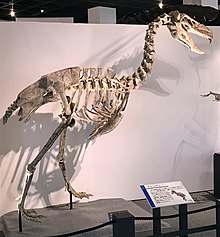Cariamiformes
| Cariamiformes Temporal range:
Suspected, but still not confirmed, late Cretaceous origin by molecular clock | |
|---|---|

| |
Cariamidae )
| |

| |
| Kelenken (Phorusrhacidae) | |
| Scientific classification | |
| Domain: | Eukaryota |
| Kingdom: | Animalia |
| Phylum: | Chordata |
| Class: | Aves |
| Clade: | Australaves |
| Order: | Cariamiformes Fürbringer, 1888 |
| Families | |
|
Cariamidae † Ameghinornithidae[1] †Bathornithidae †Elaphrocnemus[2] †Idiornithidae †Phorusrhacidae ?† Qianshanornithidae †Salmilidae | |
Cariamiformes (or Cariamae) is an order of primarily flightless
This proposal has been confirmed by a 2014 study of whole genomes of 48 representative bird species.[5] This analysis shows that the Cariamiformes are basal among extant Australaves, while falcons are next most basal; in combination with the fact that the two most basal branches of Afroaves (New World vultures plus Accipitriformes, and owls) are also predatory, it is inferred that the common ancestor of 'core landbirds' (Telluraves) was an apex predator.[5] However, some researchers like Darren Naish feel that this assessment is biased towards the more well known, predatory representatives of the clade,[6] and indeed at least one form, Strigogyps, appears to have been herbivorous.[7]
The earliest known unambiguous member of this group is early
Molecular
| Australaves |
| |||||||||||||||
References
- ^ Mayr, G. 2005. "Old World phorusrhacids" (Aves, Phorusrhacidae): a new look at Strigogyps ("Aenigmavis") sapea (Peters 1987). PaleoBios
- ^ Alvarenga, H., Chiappe, L. & Bertelli, S. 2011. Phorusrhacids: the terror birds. In Dyke, G. & Kaiser, G. (eds) Living Dinosaurs: the Evolutionary History of Modern Birds. John Wiley & Sons (Chichester, UK), pp. 187-208.
- S2CID 6472805. Retrieved 2008-10-18.
- ^ PMID 26444237.
- ^ PMID 25504713. Archived from the original(PDF) on 2015-02-24. Retrieved 2015-08-29.
- ^ Naish, Darren. "Bird behaviour, the 'deep time' perspective". scientificamerican.com. Retrieved 12 April 2018.
- Middle Eocenebird Strigogyps sapea (Ameghinornithidae)
- S2CID 246810485.
- ^ Case, J.; Reguero, M.; Martin, J.; Cordes-Person, A. (2006). "A cursorial bird from the Maastrictian of Antarctica". Journal of Vertebrate Paleontology. 26 (3): 48A.
- PMID 31333904.
- doi:10.26879/1340.

